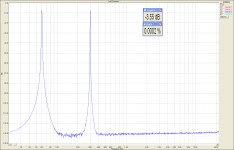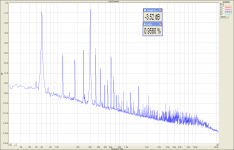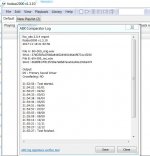One definition of linear distortion is where no new frequencies are introduced but the amplitude and phase of original frequencies may be modified. Non-linear includes the addition of new frequencies. To put it simply but not comprehensively.
I get that taming the linear distortions in speakers is a major challenge and must consume the mjority of the design effort. Perhaps the drive unit makers have more focus on non linear distortion mechanisms.
I get that taming the linear distortions in speakers is a major challenge and must consume the mjority of the design effort. Perhaps the drive unit makers have more focus on non linear distortion mechanisms.
...for me the stuff that by current reckoning is not audible and is dismissed does indeed affect the audible that's why is fail to understand the lack of concern.
By audible it is usually meant, audible to most people most of the time, maybe to 95% of people 95% of the time, at least according the measurement method used.
If you happen to fall a little outside of that, things may annoy you that don't bother most people. Little is to be gained by arguing about it. Just make sure you aren't fooling yourself is all, which is bound to happen at times for everybody. You can try better equipment to see if you can find something that doesn't annoy you, is about all as a practical matter. Its probably easier than getting other people to change their minds, particularly if they have already firmly decided what they believe.
Definitions:
Linear distortion are things whose aberrations do not change with signal level like frequency response or perhaps phase response. Other things like diffraction are linear and are independent of level although their perception appears to change with level.
Nonlinear distortions are aberrations that are level dependent or maybe thermal dependent (highly correlated with level.) Nonlinear distortion adds new signal content into the output that is not in the input, like noise, but the nonlinear content is highly correlated with the signal, noise is not. Nonlinear is quite complicated to analyze, not easily fixed with electronics or even design. Its audibility is quite controversial as this thread will testify to.
Linear distortion are things whose aberrations do not change with signal level like frequency response or perhaps phase response. Other things like diffraction are linear and are independent of level although their perception appears to change with level.
Nonlinear distortions are aberrations that are level dependent or maybe thermal dependent (highly correlated with level.) Nonlinear distortion adds new signal content into the output that is not in the input, like noise, but the nonlinear content is highly correlated with the signal, noise is not. Nonlinear is quite complicated to analyze, not easily fixed with electronics or even design. Its audibility is quite controversial as this thread will testify to.
Perhaps the drive unit makers have more focus on non linear distortion mechanisms.
They do and they have, to the point where most of the serious nonlinear problems have been solved. Not so much for the linear stuff.
When I started working with B&C a major part of our focus was on nonlinear distortion. But after several tests we found that these were not the audible problems. It was always the linear stuff. Our results, which were all published, did not sit well with many people.
Why has this thread been hijacked from an interesting test of speaker distortion audibility into a discussion of its futility?
There seemed to be good progress in identifying distortion on pure tones vs in music, then the thread went off the rails. It would be nice to get back to the tests and thresholds.
There seemed to be good progress in identifying distortion on pure tones vs in music, then the thread went off the rails. It would be nice to get back to the tests and thresholds.
Definitions:
Linear distortion are things whose aberrations do not change with signal level like frequency response or perhaps phase response. Other things like diffraction are linear and are independent of level although their perception appears to change with level.
Nonlinear distortions are aberrations that are level dependent or maybe thermal dependent (highly correlated with level.) Nonlinear distortion adds new signal content into the output that is not in the input, like noise, but the nonlinear content is highly correlated with the signal, noise is not. Nonlinear is quite complicated to analyze, not easily fixed with electronics or even design. Its audibility is quite controversial as this thread will testify to.
that mashes up my understanding further!
the term "linear" implies a direct relationship between two quantities,no?
i'm not saying that it's a one to one ratio just that the relationship is fixed.
non linear can vary the quantities via an infinite number of functions which is why they are hard to deal with.
i feel the terms are misapplied in some instances.
i wish frequency response never varied with level... most drivers i've encountered seem to live by a monotonic function.
frequency response is the domain of amplitude distortion.
if amplitude does not change with frequency i would say it's "linear" if amplitude varies with frequency it's "non (not) linear"
diffraction i may not know enough about so i'll not comment.
when you say non linear distortions are level dependent and highly correlated with level that seems to suggest a linear as opposed to non linear relationship,no?
IMD produces new frequencies that are sum and difference and HD integer multiples, i'm unclear as to whether these are linear or non linear.
i've always viewed these as non linear.
(this may be a bad time to invoke humor but i've always wanted to create a new term- REPRODUCTIVE DISTORTION two frequencies modulate and make a new frequency!)
and for me there is still a whole host of waveshapes that need classification.
a triangle waveform can be non symmetrical (fast rise time, long decay or the inverse) is it linear or non linear?
OK, in case that anyone is still interested, there is a test on 60Hz + 300Hz intermodulation
http://pmacura.cz/60+300_speaker.zip
Again, there is an original digitally generated file and a recorded file from 7" woofer, at about 10cm distance, at 4Vrms signal level.
It seems to be almost indistinguishable, so try yourself and let me know your result, possibly supported by a positive ABX protocol.
I originally wanted to use a 30+300Hz tets, but the linear amplitude error from the woofer made it unusable.
Edit: spectra attached. This time I have not removed the room and microphone noise.
http://pmacura.cz/60+300_speaker.zip
Again, there is an original digitally generated file and a recorded file from 7" woofer, at about 10cm distance, at 4Vrms signal level.
It seems to be almost indistinguishable, so try yourself and let me know your result, possibly supported by a positive ABX protocol.
I originally wanted to use a 30+300Hz tets, but the linear amplitude error from the woofer made it unusable.
Edit: spectra attached. This time I have not removed the room and microphone noise.
Attachments
Last edited:
Interest is very high Pavel. Having a real speaker designer’s experience in your thread enhances it, in my opinion.
Would you please show the mathematical formula you have applied to the previous files?
Would you please show the mathematical formula you have applied to the previous files?
Last edited:
Although I’m using an iPhone and Apple earbuds right now, the similarity of the sound of the source tones and the live playback is unexpected. I notice some extra “bloom”, for want of a better term, on the live version but it is subtle. I’ll try on a proper hifi later.
Would you please show the mathematical formula you have applied to the previous files?
The previous 2 files (flute concert and 30+300Hz) had a non-linearity that was described (by transfer curve plot and spectra at various amplitudes) in post
Audibility of speaker nonlinear distortion - test
The distortion was added by Keith Howard's software.
The latest test, 60+300Hz, is an original vs. recorded from 7" woofer.
Also, the list of test files is continuously updated in the 1st post of this thread.
Last edited:
Thanks. I plead guilty to not thoroughly reading this thread. I tend to dip in and out.
I would be interested to know the actual mathematical equation(s) you used (as opposed to the transfer function graph).
I auditioned the 60+300 samples on my hifi at moderate volume. I could not reliably distinguish them even when knowing which one was which. I recruited an 18 year old to blindly audition as well and the ability to distinguish was 2/3 at best, with a "feeling" that the distorted might have more fullness in the bass in some way. But essentially, so far, no statistical difference. This was in my lounge with some other household noises going on and the whir of a PC. I haven't tried using headphones.
I'm guessing Mooly will find a difference once more...by injecting his own "bootstrapping" distortion? 😉
I would be interested to know the actual mathematical equation(s) you used (as opposed to the transfer function graph).
I auditioned the 60+300 samples on my hifi at moderate volume. I could not reliably distinguish them even when knowing which one was which. I recruited an 18 year old to blindly audition as well and the ability to distinguish was 2/3 at best, with a "feeling" that the distorted might have more fullness in the bass in some way. But essentially, so far, no statistical difference. This was in my lounge with some other household noises going on and the whir of a PC. I haven't tried using headphones.
I'm guessing Mooly will find a difference once more...by injecting his own "bootstrapping" distortion? 😉
Last edited:
At higher volume it was easy to tell. One had a more distinctive high frequency buzz to it.
foo_abx 2.0.4 report
foobar2000 v1.3.16
2017-11-18 12:50:54
File A: 60+300_orig.wav
SHA1: 37bf250fcd70b6a84b52d440186a0f6731c1f250
File B: 60+300_rec.wav
SHA1: 66d8f817fd13fc59a7a8b87ace61e40e19c6e474
Output:
WASAPI (event) : Digital Audio (S/PDIF) (High Definition Audio Device), 16-bit
Crossfading: NO
12:50:54 : Test started.
12:51:34 : 01/01
12:51:51 : 01/02
12:52:14 : 02/03
12:52:36 : 03/04
12:53:07 : 04/05
12:53:25 : 05/06
12:53:43 : 06/07
12:53:57 : 07/08
12:53:57 : Test finished.
----------
Total: 7/8
Probability that you were guessing: 3.5%
-- signature --
af79cab002591ad5d9812e979ce549780c42e92d
First, congratulations to your ABX result, and I agree that audibility of perturbations strictly depends on listening level.
Unfortunately, I am not able to provide this. The non-linear distortion added is a product of Keith Howard's adddistortion software, that may be downloaded for free from
Freeware
It uses a polynomial transfer function to create a non-linear transfer curve. Your input are levels of harmonics that apply to full scale signal. Please download his zip file which contains explanations as well, at least I hope so.
So I am trying, from a set of measurements and known harmonics amplitudes at different level, to find a similar polynomial transfer function, in case that the files are simulated. Otherwise, I use direct recorded files with pure tones or twin-tones as a stimulus.
From Keith's article:
Euphonic Distortion: Naughty but Nice? Crunching the Numbers | Stereophile.com
For more info, please visit the link above.
---------------------
P.S.: my ABX, apologies it is from old computer with win XP and old foobar version
I would be interested to know the actual mathematical equation(s) you used (as opposed to the transfer function graph).
Unfortunately, I am not able to provide this. The non-linear distortion added is a product of Keith Howard's adddistortion software, that may be downloaded for free from
Freeware
It uses a polynomial transfer function to create a non-linear transfer curve. Your input are levels of harmonics that apply to full scale signal. Please download his zip file which contains explanations as well, at least I hope so.
So I am trying, from a set of measurements and known harmonics amplitudes at different level, to find a similar polynomial transfer function, in case that the files are simulated. Otherwise, I use direct recorded files with pure tones or twin-tones as a stimulus.
From Keith's article:
Euphonic Distortion: Naughty but Nice? Crunching the Numbers | Stereophile.com
To add a desired pattern of nonlinear distortion to a signal, you must first calculate the
required polynomial expression relating output amplitude 👍 to input amplitude (x), which
takes the general form
y = ax + bx2 + cx3 + dx4 + ...
.
.
From this it follows that to add 10% (0.1 x cos2θ) second harmonic distortion to the input
signal, the transfer characteristic must be
y = x + 0.2x2 – 0.1
.
Similar identities can be written for the other harmonics, although the equations become
more complex the higher in order you go. The identity for the fifth harmonic, for instance, is
cos5θ = 5cosθ – 20(cosθ)3 + 16(cosθ)5
and the transfer characteristic for adding 10% fifth harmonic distortion is therefore
y = 1.5x – 2x3 + 1.6x5
For more info, please visit the link above.
---------------------
P.S.: my ABX, apologies it is from old computer with win XP and old foobar version
Code:
foo_abx 1.3.4 report
foobar2000 v1.1.6
2017/11/18 15:44:16
File A: C:\Documents and Settings\Administrator\Dokumenty\Hudba\Mereni repro pokusna\60+300_orig.wav
File B: C:\Documents and Settings\Administrator\Dokumenty\Hudba\Mereni repro pokusna\60+300_rec.wav
15:44:16 : Test started.
15:45:29 : 01/01 50.0%
15:45:37 : 02/02 25.0%
15:45:45 : 03/03 12.5%
15:45:52 : 04/04 6.3%
15:46:09 : 05/05 3.1%
15:46:24 : 06/06 1.6%
15:46:33 : 07/07 0.8%
15:46:43 : 08/08 0.4%
15:46:58 : 09/09 0.2%
15:47:13 : 10/10 0.1%
15:47:26 : 11/11 0.0%
15:47:38 : 12/12 0.0%
15:47:57 : 13/13 0.0%
15:48:06 : 14/14 0.0%
15:48:17 : 15/15 0.0%
15:49:48 : Test finished.
----------
Total: 15/15 (0.0%)
Last edited:
There is quite a noticeable difference with these. With earbuds, the bass is far more prominent on the original than on the recording.
Code:
foo_abx 2.0.4 report
foobar2000 v1.3.16
2017-11-18 18:20:28
File A: 60+300_orig.wav
SHA1: 37bf250fcd70b6a84b52d440186a0f6731c1f250
File B: 60+300_rec.wav
SHA1: 66d8f817fd13fc59a7a8b87ace61e40e19c6e474
Output:
DS : Primary Sound Driver
Crossfading: NO
18:20:28 : Test started.
18:20:39 : 01/01
18:20:48 : 02/02
18:20:53 : 03/03
18:21:02 : 04/04
18:21:09 : 05/05
18:21:17 : 06/06
18:21:24 : 07/07
18:21:35 : 08/08
18:21:35 : Test finished.
----------
Total: 8/8
Probability that you were guessing: 0.4%
-- signature --
2618748bfe259d86adfb81e13bd4adaa76cb4c2eWith regard to adding nonlinear distortion, to assure no frequency aliasing occurs, it is necessary to band limit test file frequencies or upsample before distortion is added, then anti-alias filter, and then down-sample in order to get valid results.
Multiplication by a 2nd order polynomial can produce harmonics up to the 2nd, by a 3rd order polynomial harmonics up to the 3rd can be produced, and so on.
Therefore, not knowing how Keith's distortion program was written, it might be a good idea to test it with some higher order distortion added to a HF test signal that would be expected to produce aliasing artifacts if nothing is in the program to prevent it.
If aliasing is found, then using the distortion program with most music would be expected to also produce aliasing, which could affect ABX results.
Multiplication by a 2nd order polynomial can produce harmonics up to the 2nd, by a 3rd order polynomial harmonics up to the 3rd can be produced, and so on.
Therefore, not knowing how Keith's distortion program was written, it might be a good idea to test it with some higher order distortion added to a HF test signal that would be expected to produce aliasing artifacts if nothing is in the program to prevent it.
If aliasing is found, then using the distortion program with most music would be expected to also produce aliasing, which could affect ABX results.
One not so difficult technique to simulate speaker distortion might be to convert the input voltage to expected displacement and apply the driver's transfer function to the displacement. Then convert back to SPL output with the inverse function. First order integration then derivative could be a starting point. Just an idea.
Most I see here are all still for a flat amplifier with a non-linear transfer function not speakers.
Most I see here are all still for a flat amplifier with a non-linear transfer function not speakers.
Last edited:
Scott, this is precisely how it should be done if the non-linearity are small. But if the non-linearity is large then there can be cross terms (between orders) that won't transform this way. Basically this is the distortion of the distortion and on and on. This is why exact impulse response of a non-linearity of order n is an impulse in n dimensions. Nearly impossible to analyze (see Volterra Series). Fortunately I think that for the most part the non-linearity are small enough and this procedure should work. I suppose if the non-linearity were large enough to be a problem it wouldn't be a very satisfactory system anyways.
This was discussed briefly in my papers on the subject.
This was discussed briefly in my papers on the subject.
Wasn't Pavel's latest 2 tone test recorded thru a real speaker at 4 volts?Most I see here are all still for a flat amplifier with a non-linear transfer function not speakers.
Sure, the test file was recorded from speaker at 4Vrms and for comparison there is a generated tone.
- Status
- Not open for further replies.
- Home
- Loudspeakers
- Multi-Way
- Audibility of speaker nonlinear distortion - test


